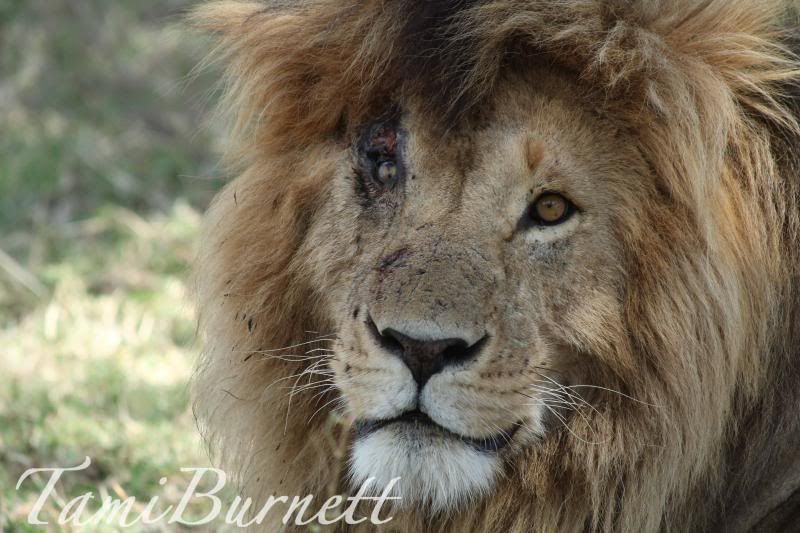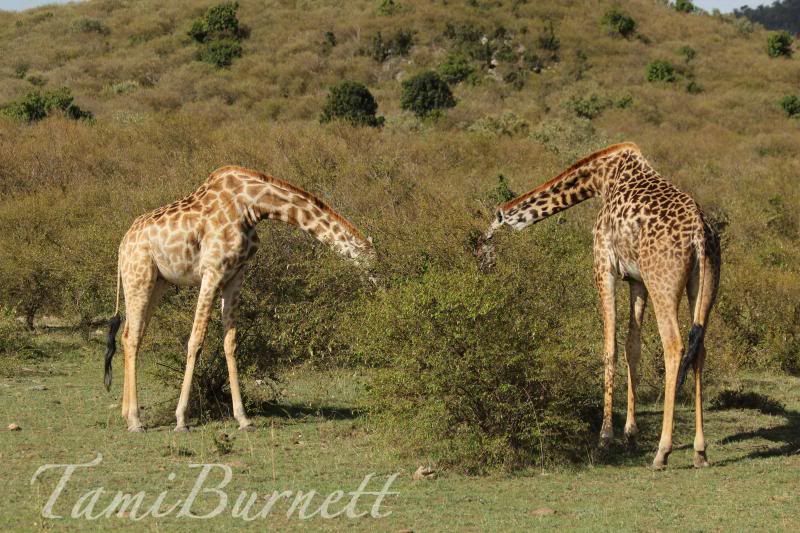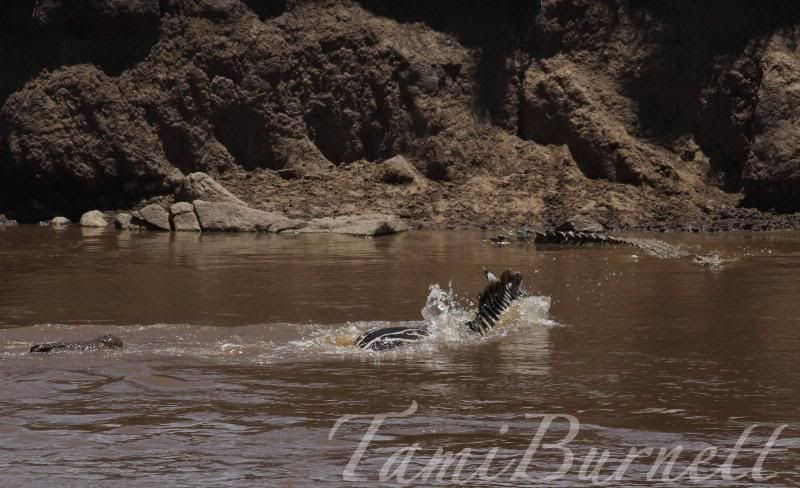i remember as a child watching a glimpse of a National Geographic documentary with lions chasing down & killing various animals. i remember being disturbed at the gruesome sight. i've seen pictures of the wildebeest migration & watched The Lion King and have vaguely wondered about this far away land called Africa. Not in my wildest dreams could i ever imagine i would get to actually visit the same places i had seen on TV and my children would see it themselves first hand.
We originally planned our trip for the Eid school holiday which is in October but when we were informed that we would have a better chance of catching The Migration if we traveled in September, we didn't even blink an eye at pulling our kids out of school 2 weeks after it started.
We were heading to what has been called one of the great wonders of the world....
Migration on the Mara!
i understand that regardless of the time of year you visit the Masai Mara your odds of seeing the Big Five are quite high. The Big Five is a term coined way back in the day by hunters. It refers to the 5 most difficult animals to hunt on foot (Wikipedia). Hunting in Kenya is no longer allowed unless on private game reserves but we had high hopes of doing our own sort of hunting. We came to play the best Eye Spy game ever! Searching for Big Five Awesomeness.
# 1. ELEPHANT
# 2. CAPE BUFFALO
You can tell the age and the sex of the Buffalo based on the size and shape of their horn.
(The birds picking the ticks & flies out of their ears, nose & eyes were just an extra bonus sighting.)
# 3. LION
This young male was actually hiding in the bushes and leery of the herd of buffalo passing through. He was eyeing them carefully & once they got too close to him he quietly stole away to another bush.
What was so awesome about this trip is that we didn't experience just one sighting of these amazing creatures. We were able to sit and watch them several times a day in different settings.
We watched cubs wrestle while the mama lionesses were lounging in the shade
We saw a lovely couple...
This full grown black maned lion fought to prove himself worthy of the territory. Male lions typically have a shorter life span due to the constant fighting they engage in.
i am not kidding when i say we got to see everything!
Sitting 15 feet away from a lion pride is pretty spectacular especially considering we were sitting in a jeep with completely open windows. Our friends were in more of an enclosed jeep.
Morning and evening walks of the lion pride.
We had the wide open, no windows or top, hang on to the handles or you might fly out the side model jeep. It was AWESOME!
We had the wide open, no windows or top, hang on to the handles or you might fly out the side model jeep. It was AWESOME!
# 4. RHINOCEROS
Our driver guided us by foot up a hill and insisted we walk quietly with NO talking. Once we got to the top we saw this. These are actually the White Rhino not the Black Rhino which is technically one of the Big 5. It is called White not because if its color but because of its lip shape and color.
There were guards standing nearby. These rhinos are protected from poachers & are used to seeing people around. However, there was absolutely nothing separating us from them.
# 5. LEOPARD
The leopard is usually the most difficult to SPOT! The joke among safari drivers is that the leopard can only be found if someone from the group decides to stays behind. It was the 9th and final day of our safari on the 6:30 am game drive, when Chris made a last minute decided to sleep in (and for that we thank him) the kids and i went with Wilson our driver and we SPOTTED the Elusive Leopard!!
Wilson was amazing BTW! He had blankets for us to bundle up in on early morning drives and ice chests full of drinks for us in the warm afternoon. He asked us what we wanted to see while we were here and he made sure it happened. He drove over the most dusty and rocky roads to get us as close to the animals as possible. We knew when he got a call on his radio & he started speaking Swahili something might be up. If after that call he made a sudden turn & sped up we KNEW something fabulous was about to be discovered. Our last day, he spent 45 minutes hunting down that leopard for us. At times he was going so fast blankets were flying out the windows & the kids had to hang on for dear life or else they would spill out the side. But as you can see at the end of the drive the smiles were bigger than ever.
If it weren't for the wild animals calling to us we might never leave our tent. We stayed in a beautiful "tent" hotel that sat right above the Mara River. It is one of the only times a hotel's boasting advertisement of "hippo and crocodile infested waters" is actually a wonderful bonus!
The camp is surrounded by an electrical fence to keep animals at bay. Since the tents are located on so steep a hill there is no worry about a hippo climbing up to our tent. At midnight all electricity is turned off and the grounds become pitch black. The stars are brilliant and in the middle of the night we heard hyenas, hippos, monkeys and all sorts of other animals.
In the mornings we were awoken with the Swahili greeting "JAMBO!" and a tray of hot chocolate & coffee delivered to our tent to warm us for the early morning drive.
Outside deck
Inside...
The Big Five certainly were amazing but there so many other types of wildlife beckoning us to come and see them.
Babies, Mamas, Daddies, Eating, Drinking, Walking, Peeking, or Running, i never got tired of the giraffe!
Thompson Gazelle proving their manhood
Impala
Cheetahs lounging in the shade
Cobra and bird trying to decide who will eat who
Watering hole for Wildebeest and Zebras
Hippos
Interestingly enough, the hippo was one of the animas we kept the biggest distance from as they are considered the most dangerous.
(Those "lumps" of laziness in the water are hippo)
Interestingly enough, the hippo was one of the animas we kept the biggest distance from as they are considered the most dangerous.
(Those "lumps" of laziness in the water are hippo)

Once and awhile we were able to get out of the jeep as long as Wilson made sure there were likely no animals nearby. However, with a sign like this you had to plan your potty stop wisely.
There are no seat belt laws out on the Mara so my kids spent most of
their time driving around standing on the seats with their heads popping out of the top all giraffe like...Sunsets are brilliant!
SPOILER ALERT: Carnage ahead

Early mornings we found Hyenas cleaning up leftover meals from the night before.
Lionesses with last nights dinner still on her mouth
Jackals eating Gazelles and stealing away their sleeping babies.
We soon discovered that Migration ebbs and flows and is quite unpredictable. What you see on TV does happen but it is not a constant flow. Some days the wildebeest are stampeding through, other days they walk quite orderly to the river crossing. A major crossing occurred a few days prior to our arrival.
Wilson drove us an hour from our lodge to one of THE Mara crossing points. It is the spot where the National Geographic team camps out to get good footage of wildebeest flinging themselves into the river.
Once at the river we realized the wildebeest would take a few hours to arrive. However, there were already zebras quite anxious and ready to cross. Wilson parked us right on the bank and we watched real life Animal Planet.
Zebras trot down to the river from a small slope above.
They stand on the bank and watch the 4 crocs glide past.
For obvious reasons they turn back.
After about 3 times of back and forth running from slope to the bank one zebra decides to cross.
Wilson told us that what usually happens during migration is one zebra or wildebeest decides to cross and when it does the rest blindly follow.
The events that unfold from here is what Kyle describes as
"SADLY AWESOME"
We see crocs surround the first zebra and lots of splashing and thrashing occur.
REALLY! A croc in front and behind!
Just when we think he is going to be a goner, he makes it out.
We can't help but be amazed at how many are actually crossing the river.
SURVIVOR!
It was only a matter of time before their luck ran out though.
The croc bites the neck and rolls it in the water to drown it.
We can actually hear the zebra crying out.
About 30 attempted to cross and the majority of them make it
It appears that three of them don't
Although the crocs were very difficult to count we originally spotted 4-5 when we first arrived by the end of the feasting we counted 17 crocs swimming around and sharing the meal.
This sad zebra who succeeded in crossing, paced back and forth crying out after seeing the zebra and crocodile struggle.
Further down the river away from the original crossing spot i snapped this telling picture.
One lone zebra who decided not to cross with the group is pacing the bank as crocs feast on 2 different zebra hides.
The entire time this was happening we stood in our jeep captivated, shocked, tense and anxious. Once the crossing was over we all sort of exhaled as if we had been holding our breath as an effort to help the zebras across.
i asked Wilson WHY do they cross. i mean really?! What is on the other side that isn't here?! Both sides look the same to me. He said he didn't know really, maybe family herd was on the other side but it is just IN them to cross.
One full Croc.
This time in Africa was one of the most amazing experiences.
We were in constant awe of God's unique and diverse creation.
Safely standing in the middle of Masai Mara
Before we left Dubai for our Safari i heard a saying that goes something like this...
"It may be said that you leave your heart in SF but when you visit Kenya a bit of Kenya will always be in your heart."
and now i know it to be true.





































































